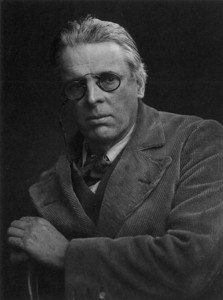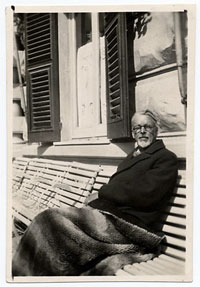As explained in my previous blog post, Yeats created an elitist, authoritarian myth of Jonathan Swift during his time spent in Fascist Italy (in the city of Rapallo). Now I am going to show you how he appropriated his reading of Swift to the Irish context and his own elitist discourse of decay.

W. B. Yeats
In The Words upon the Window-pane, Yeats puts his reading of Swift into practice. This play presents a séance situation in a Dublin lodging-house. The dramatis personae include a medium called Mrs. Henderson and other members of theosophical societies and one highly educated intellectual named John Corbet, a Cambridge scholar of Swift, who shows a sceptic attitude towards Mrs. Henderson’s activity. The participants expect the medium to evoke the ghosts of their dead relatives, because they would like to ask for their advice mainly on financial issues. Therefore, their petty, money-oriented expectations clearly identify them as members of the middle class whom Yeats despised. However, these middle-class expectations are frustrated by the appearance of the ghost of Swift followed by the spirits of his lovers Vanessa and Stella. Even though Mrs. Henderson starts to evoke the dead relatives, suddenly she begins to speak in the voices of Swift, Vanessa and Stella and thus acts out the drama of the dead. The participants see Swift’s ghost as an evil spirit and a dirty old man and accordingly, want to chase this sinister, overwhelming figure of the past away.

Yeats in Rapallo
In the context that I have outlined, however, this can be seen as the rejection by the middle class of any attempt to continue the values of the great eighteenth century. What Swift’s ghost interrupts is the petty daily matters of the middle class, and he overwhelmingly replaces them with nobler concerns of love, political greatness, and the conflict between matters of the state and matters of the heart. Thus even though Yeats creates the impression that the play dramatises Swift’s complicated love life, what it really achieves is a fervent critique of the middle-class and a promotion of the rule of the educated and aristocratic Few represented here by the ghost of Swift.
One possible interpretation is that Swift represents the educated Few, while Mrs. Henderson epitomises the interests and dangers of the rule of the masses (the Many). And these two visibly clash in the play. By the end of the séance, Swift’s voice starts to dominate and he completely possesses Mrs. Henderson, oppressing her identity and will. It is Swift’s voice that triumphantly concludes the play. Thus Yeats illustrates the triumph of this intellectual aristocracy over the middle-class and eventually presents this “dirty old man” almost as a superior man of intellect towering above every other character. By the end of the play, each character is silenced, and even though Mrs. Henderson tries to return to her own reality, her voice too is totally oppressed. Her oppression by the great figure of Swift is presented as something natural as if this ghost had the right to oppress the others for a nobler cause—that of the Irish nation.

The city of Rapallo
However, this is not a pure triumph at the end of the play. There is much more to this story. If you would like to hear why, come to the Department’s mini-conference on 12 May (Tárogató, 10:15 am), where I am going to give a detailed presentation on Yeats’s reading of Swift. Also, on 10 May at 14:00 I am going to present this paper in Hungarian at the ‘La lecture comme expérience de vie’ (Reading as Life Experience) symposium in Sophianum.
Sources:
Yeats, William Butler. The Collected Plays of W. B. Yeats. London: Macmillan, 1982. Print.
Source of Images:
Multitext Project in Irish History, Emory College Irish Studies Program

